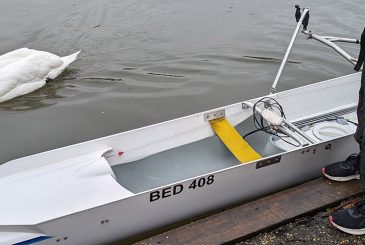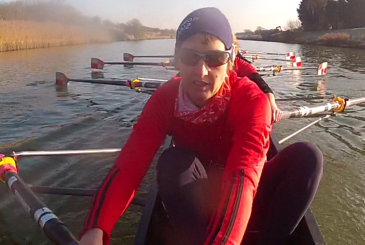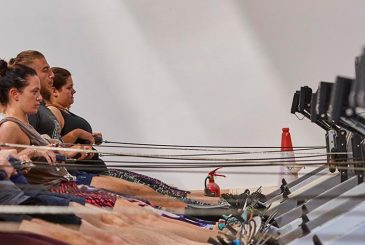Ro Price from Cantabrigian Rowing Club and Monmouth rower and cox Patricia Carswell were guests in our British Rowing coxing webinar last March. They talk to Toby Bryant about different coxing scenarios
All coxes have had the question from family or friends, ‘so, you’re the one who steers the boat?’
As much as the answer to that is yes, coxes know the discipline is so much more. Steering, safety, motivation and coaching are just four of numerous other aspects that are part and parcel of every cox’s session.
Earlier this year British Rowing hosted a webinar focusing on how the rowing community can better value the work of coxes with Ro Price and Patricia Carswell.
Ro first entered the rowing world when roped in by a Manchester University friend across the corridor who needed a cox for Women’s Henley Royal Regatta. Ro, who was “small and mouthy”, fitted the bill. Since then, she has gone on to cox at Agecroft RC, Vesta RC and now helps coach colleges at Cambridge University.
Patricia also first started rowing at university level but only for a few weeks. It wasn’t until she was 40 when she returned to the sport with Monmouth RC. She soon realised that “people seemed to do what they were told and I had the confidence to tell them” which, coupled with her 5ft3 height, led her to the coxing seat. Since then, she’s taught herself everything she knows and relished learning on the job.
We put three scenarios to Ro and Patricia to pick their brains for nuggets of advice fellow coxes could use.
1 – For beginner coxes during their early sessions
Ro: “The coach should let the cox concentrate on their steering and observe what they can see from their seat – it’s important to get a feeling for things. The coach should do more of the ‘coaching’ element that comes with coxing for now.”

Patricia: “I would say talk to the crew beforehand. Be really clear about what they want out the session, so everyone is on the same page.
“From the very moment you go into the boathouse and get hands-on, you have to make it very clear you’re in charge too. Don’t let the crew give the calls to get the boat out. You’re giving them right from the start, that will make them feel confident in you.”
2 – How to motivate crews during long head races
Ro: “There are two things you can do – the first is having collective landmarks. In a head race, it’s important to have a strong and communicated race plan which should be written at least a week before.
“Secondly, you can call individual people out. Spend time with rowers before the race, either going along to land sessions or even working out with them. Then you know if you have that strong person in the crew who will respond well. Call to them and that can motivate the others too.”
“There’s nothing worse than being told it’s 10 strokes left to go and it’s 20!”
Patricia: “If it’s a really long one, like Head of the Dart, I might just chat for a while. I’ve heard of coxes singing, chatting, giving anecdotes etc. That said, do remember not to talk for the whole thing! If no one shuts me up I can talk from start to finish, I have to remind myself that. Remember they need a break from your voice as well, just to think about what they are doing.”
3 – How to keep crews concentrated during regatta races
Ro: “Provide information to the crew so that they don’t have to look out the boat. I’d come out of the first 20 strokes, look across and say something like, ‘level with crew six on the left and level with number four’ so they know what’s going on.
“It’s tempting to lie a little bit about distances when it’s hard going, but don’t do that. If you get caught, you’ll lose the trust of the rowers. Never count down the number of strokes to the line either, unless you are 100% sure that you’re right. There’s nothing worse than being told it’s 10 strokes left to go and it’s 20!”
Patricia: “I modulate my voice to make sure it’s low and calm. If needs be, I’ll get them to take the rate down, if they’re getting so frantic that they are losing length.”

4 – How to make sure coxes are valued correctly
A lot of the conversation around valuing coxes is often around weight. During our webinar, both Ro and Patricia point out that a cox is so much more than that.
Ro elaborated: “On the UK club scene, you’ve probably got 20-40 kilos sitting on your rowers collectively that they should be working on before they start pestering you. It is similar to a jockey.
“You’d choose a better jockey for your horse that weighs five kilos heavier than a really skinny jockey that was not so good. They might weigh nothing, but if they can’t motivate or make decisions quickly then they aren’t going to be worth the same as someone who is heavier and can win a race for you.”
“I think everyone should have a go at coxing and understand what a responsibility it is and how it’s not that easy”
In terms of what rowers can be doing at training to make sure the cox feels a valued part of the squad, Ro highlights feedback as a priority and ensuring that coxes are involved in all aspects.
She jokingly adds: “If you have crew nights out, don’t forget the cox too!”
Patricia says that she has never felt undervalued by her club and points to the fact that everyone has experience of coxing as a help in that.
She says: “I think everyone should have a go at coxing and understand what a responsibility it is and how it’s not that easy. That’s why in my club it works so well, everyone knows how hard it can be and what a big responsibility it is.”
5 – Steering tips
As much as coxing is a lot more than steering – the lefts and rights are a pretty important part of the job. Ro and Patricia are on hand with a few pieces of advice.
Ro: “The most important thing is to try and anticipate your steering as much as you can and do it as little and as gently as possible.
“Another is to tell the rowers you’re doing it. I would often say, ‘rudder going on in 3,2,1’, then they know to anticipate it and can expect some kind of balance switching.
“Common errors are oversteering and being too reactive. Then you end up with boats bouncing side to side!”
“Reading a river is really important – one of our best coxes is a Geography teacher!”
Patricia agrees with avoiding oversteering: “It’s a bit like when you learn to drive and get to grips with the steering wheel – eventually you don’t even realise you’re doing it. It’s just practice, and you get better at it.
“Think further ahead too. Rather than dealing with the here and now, think about what might be coming.”
Patricia also points to fully appreciating the conditions as an aspect often overlooked.
She says: “Often people just think about steering as moving the rudder. It’s all very technical but when you get on a real boat on the river you discover it doesn’t do what it’s meant to do. You end up out in the middle or there’s a bit of current going on, for example.
“Reading a river is really important – one of our best coxes is a Geography teacher! The reason she’s so good at steering is she can read ripples and understands the bends… it’s a mystery to me but she’s great at that.”
British Rowing Coxing webinar
Watch our webinar on coxing skills with Ro and Patricia answering questions, drawing on experience, around topics such as training, competencies, roles and responsibilities and selection of coxes. You can view it here.
Photos: Ben Rodford Photography










